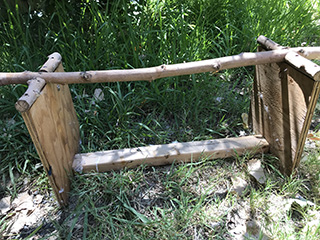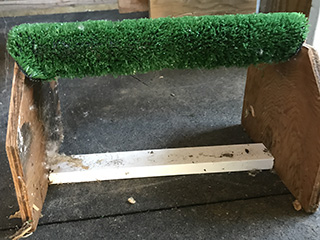Helping Hands
If you are wondering what Helping Hands volunteers do to help wildlife without actually working with wildlife, you have come to the right page. There are many things we need custom-built for rehabbing these patients. Also, upkeep with landscaping and maintenance at the Center and our hack house are always needed.
So, if anything on the list below sounds like the project for you, scroll down the page for further information.
- Acorn collectors
- Hand-sewn nets of various sizes
- Maintenance at Center
- Upgrade at hack house
- Landscaping at Center
- Fundraising events
- Woodworking projects

Acorn Collectors

Squirrels and acorns go together like pie & ice cream! We rehabilitate over 100 squirrels here at Shasta Wildlife each year. Not only do squirrels eat acorns, but it is a huge part of raccoons’ diets as well. Also, acorn woodpecker colonies can live for months on just acorns. Many of our other local wildlife take advantage of this abundant food source and there is still plenty for collection.
By the time the acorns are ready for harvest, our Center is closed for the season. However, we have many volunteers working out of their homes year-round tending to our wildlife patients. Helping Hands collecting acorns for us in the fall would help so many of our little patients learning how to be successful when they return to the wild.
Here is what you do:
Collect acorns from valley oak, interior live oak, canyon live oak or any other native oak that our beautiful north state has to offer. When you have a nice collection (such as a 5-gallon bucket or gallon Ziploc bags filled), call our Center at 530-365-WILD and leave us a message or email us at volunteer@shastawildlife.org. We will get back to you ASAP to make arrangements to meet so that we can properly store the acorns for our next busy season.
Before you collect acorns from anywhere other than your property, please be sure and ask for permission. Happy collecting!

Hand-sewn Nets
When our rescue team goes out on raptor rescues or we need to catch birds ready for release, we are faced with a problem: the talons of birds, from small finches to the deadly grip of great horned owls, become entangled with the commercial fishing nets.
Early in Shasta Wildlife’s existence, one of our volunteers modified the commercial fishing net. Using the frame of the commercial net, removing the netting and replacing it by sewing denim material around the frame, a safe capture device was created. We still have it, but it is the only proper net we have and we would really appreciate if our sewing friends would build new ones for us.
Here is what you need:
- Nets of varying sizes – from butterfly nets to large fishing nets.
- Material that is very tightly woven like denim, bed sheets, or fleece.
- A sewing needle and thread
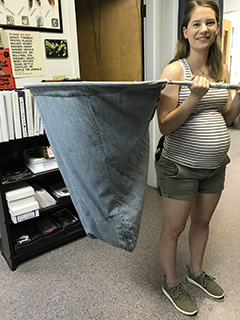
Maintenance at the Center

Our Center is always in need of repair/upgrades. Our board member/maintenance man takes on many of these tasks but is in need of handy people to lend a hand.
To sign up to help with Center maintenance, call the Center at 530-365-WILD or email volunteer@shastawildlife.org to provide your availability and learn about projects in need of improvement.
Upgrades at the Hack House
What is a hack house? Maybe you clicked on this one purely out of curiosity. Our hack house is an off-site, lakeside aviary on stilts that offers our patients the opportunity for some R&R while recuperating from their ailments. These patients usually have special criteria for care like restricted movement orders from our vet while a bone fracture is healing. The hack is also a great place for orphaned osprey to watch adult osprey catching their dinner. The hack is at the tree line on beautiful Shasta Lake. It is on Forest Service property behind a locked gate near Turntable Bay.
The hack is in need of renovation from floor to ceiling. It will require some tough love to get it back into shape. If this sounds like a task that you would like to lend a hand with, call the Center at 530-365-WILD or email volunteer@shastawildlife.org. When we have a team and a date set, we will grab supplies and materials and have ourselves a work party at the hack.
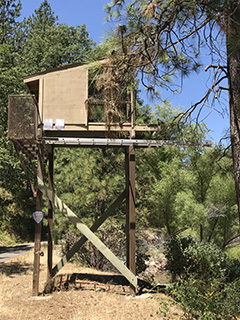
Landscaping at the Center

Our Center is located in the beautiful Anderson River Park, a serene location well suited for the type of work we do with wildlife. Busy volunteers take in orphaned/injured wildlife, and the feeding, cleaning, and caring for these leaves no time for beautifying our quiet park niche.
Volunteers lending a hand for a few hours once or twice a month can do much to improve the outward appearance of our Center. Also, creative landscapers with knowledge of our native flora could transform our Center into an ideal place to attract native birds which would in turn help to teach outdoor-aviary birds how to make a living in the vast, wild world before they are released back into it.
If this opportunity interests you, call our Center at 530-365-WILD, email volunteer@shastawildlife.org or stop by during our open season (May through August) and share your vision with us. We will get you on our flexible landscaping schedule either year-round or during times when you have availability.
Fundraising Events
At this time, Shasta Wildlife hosts three fundraising events yearly. The First Saturday in April is our Open House event. Next, on the last Saturday in October, we spookify our Center for our Creeptastic Halloween event. Finally, in late November/early December we host a Christmas play performed by and held at the Riverfront Playhouse.
We are always looking for extra hands to aid in preparation for, operation of, and clean-up at these events. One month prior to, and then again two weeks before each event, we have a meeting to discuss plans to execute these fundraisers. If you are interested in helping you can call the Center at 530-365-WILD or email volunteer@shastawildlife.org before the meetings as they are mandatory to attend before taking part in these exciting FUNdraisers!
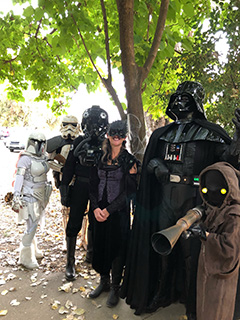
Woodworking Projects
Do you love woodworking projects but have no more room in your home for furniture? Shasta Wildlife has unique needs in furniture for our patients. From very simple to fairly complex projects, there is sure to be a job fitting to your skills.
Some of the projects include:
- Building woodpecker cages, squirrel cages, and songbird cages
- Building owl boxes
- Building nest boxes for our cavity-nesting patients
- Building perches
- Repairs to existing aviaries
There are minimum requirements set by the International Wildlife Rehabilitators Council (IWRC) that must be met for our cages.
We never use any treated lumber nor do we paint or apply anything unnatural to our woodwork.
Our perches that are attached to stands of varying heights and widths are either natural branches or covered with artificial turf.
